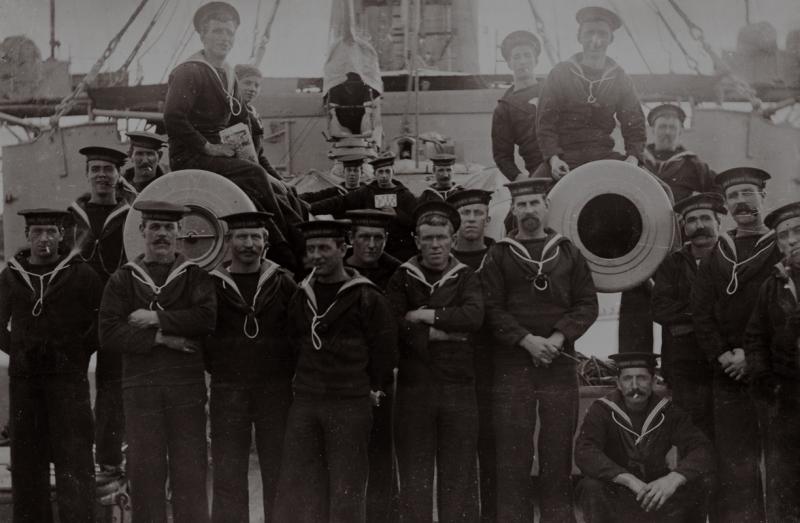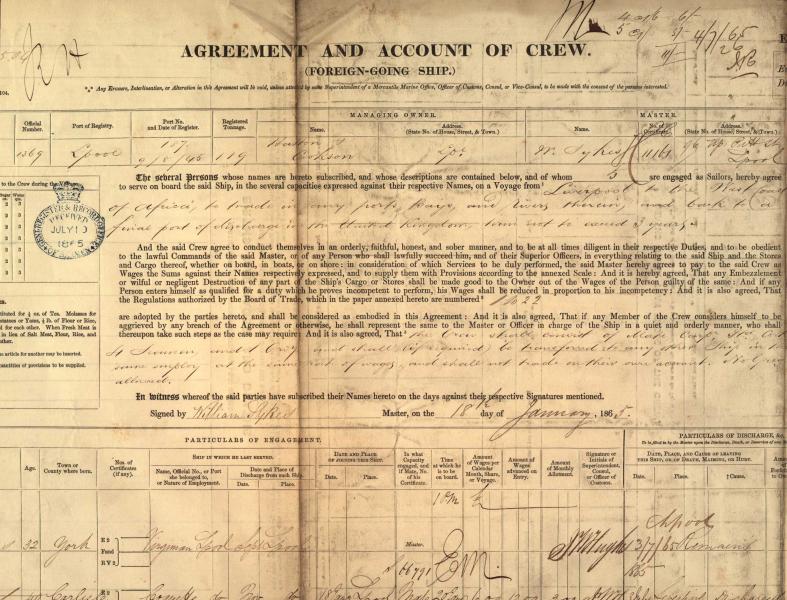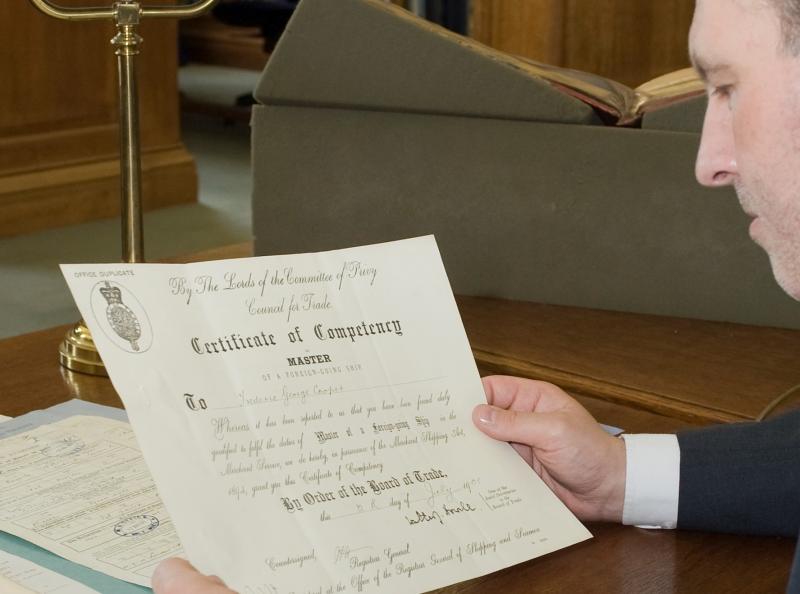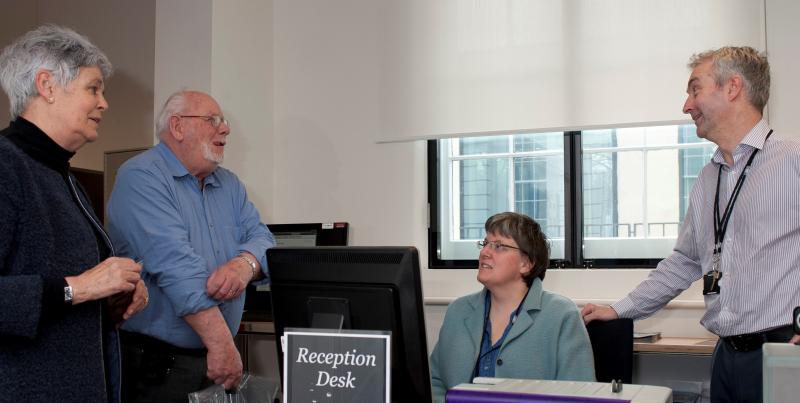Introduction
Maritime records are not usually a good starting point for compiling a genealogy but they can add considerable detail about seafaring activities of an individual.
The National Maritime Museum does not hold Royal Navy personnel records. They are kept at The National Archives. A number of these records are now online and may be accessed via their website as can a range of their Research Guides that will assist you in finding your way about the material. More information about the National Maritime Museum's resources for tracing the service records of Royal Navy personnel can be found in Research Guide B1.
In this guide we shall be concerned with material about the merchant navy and merchant ships. The aspects that will be considered are:
- Births, deaths and marriages at sea
- Crew records
- Officers' records
- Passenger records
- Shipowner records
Systematic records about ships and people who served in the merchant navy are rare before 1660. Lists of passengers kept in the UK do not survive pre-1890 and ceased to be kept centrally in 1960.
What is more, records were kept for reasons of state and commerce, not to help genealogical research. So whether you are tracing people who served or travelled on ships, you may well have a difficult search ahead. You will probably need to consult a lot of different records and you will certainly need a lot of patience.
Every collection in the museum, from maritime relics to ship models, paintings, plans, charts, uniforms and weapons will also help you build up a picture of the life and times of men and women who went to sea.
Basic bibliography
- Bevan, Amanda, Tracing Your Ancestor in The National Archives: the Website and Beyond (London: The National Archives, 7th edition, 2006).
- Cock, R and Rodger, NAM (Editors), A Guide to the Naval Records in the National Archives of the UK (Institute of Historical Research and The National Archives, 2006).
- Hogg, Peter L, Using Merchant Ship Records for Family Historians (Birmingham: Federation of Family History Societies, 1997).
- Kershaw, Roger, Emigrants and Expats: a Guide to Sources on UK Emigration and Residents Overseas (Public Record Office, 2002).
- Kershaw, Roger and Pearsall, Mark, Immigrants and Aliens: a Guide to Sources on UK Immigration and Citizenship (Public Record Office, 2000).
- Lavery, Brian, Hostilities Only: Training the Wartime Navy (National Maritime Museum, 2004).
- Papparlardo, Bruno, Tracing Your Naval Ancestors (The National Archives, 2003).
- Rodger, N A M, Naval Records for Genealogists (London: HMSO, 1988).
- Watts C T and M J, My Ancestor was a Merchant Seaman (London: Society of Genealogists, 2nd edition with addendum, 2002).
- Watts, CT and MJ, Tracing Births, Deaths and Marriages at Sea (Society of Genealogists, 2004).
All these titles are held in the Caird Library collections and can be found in the Library catalogue.
Two useful general source of information on seafarers, ships and ship owners are to be found in the Crew List Index Project and the Mariners' mailing list.
Births, deaths and marriages at sea
In tracing an event that occurred at sea, it should be remembered that the laws of more than one county may operate. For instance those of the country where the ship was registered; those applicable to its next port of call; and those of the country of which the parties are citizens or normally resident. So do not be surprised to discover multiple registrations of an event.
Births and deaths at sea
Details of births and death at sea aboard British-registered ships were, since the introduction of civil registration (1 July 1837 in England and Wales; 1 January 1855 in Scotland; and 1 January 1864 in Ireland), were required to be sent to the appropriate General Register Office depending on the nationality or normal place of residence of the father or of the deceased. (Note: records related to foreigners were, from 1875, sent to the GRO for England and Wales.)
Until 1874 these were sent directly by the ship’s captain; after that date they were transmitted via the Registrar-General of Shipping and Seamen. Each General Register Office maintains a Register of Marine Deaths with a separate index: most of these indexes are now online through several commercial organisations.
The primary record of a birth or death at sea is the ship’s official documentation. This usually means the ship’s official log, which was introduced in October 1851, but until the early 1890s may be found on the back of crew lists, including those of passengers.
Information on births and deaths at sea recorded in log books was extracted by the Registrar-General of Shipping and Seamen and entered in registers now to be found at The National Archives, in series BT 153–BT 160 covering the period 1854–1890 with a few later entries. These are being digitised and are becoming available: details are to be found on The National Archives website.
From 1891 details were copied into consolidated indexed registers kept by the Registrar-General of Shipping and Seamen: series BT 334 at The National Archives. These should cover both births and deaths that actually occurred at sea as well as on-board in port or in a local foreign hospital. Those where the event actually occurred at sea would have been reported to the General Register Office for England and Wales. Where the deceased or father was Scottish or Irish, a copy was sent to the General Register Offices in Edinburgh or Dublin.
A record of any births or deaths on a ship inbound to the UK, originating from a port outside Europe or the Mediterranean, had to be recorded on a passenger list. Those that survive (1890–1960, with a very few earlier) are in series BT 26 at The National Archives and are available online at ancestry.co.uk.
The National Maritime Museum holds:
Alphabetical Returns of Deaths of Merchant Seamen
The periods covered are July 1916–18, 1920–1989. That for 1946 also includes a supplement of merchant seamen who died while prisoners of war, 1939–1946. These returns are arranged by date (year and month) and then alphabetically by name of seaman, and contain: name, age, rank, nationality, last address, date, place and the cause of death of the seaman; and name, official number, port of registry and tonnage of vessel.
Returns of Deaths of Merchant Seamen arranged by name of ship, 1914–1919
Transcripts from the official log books recording deaths of crew are arranged by date (year and month) then alphabetically by vessel name. These include details of the circumstances that led to a death and sometimes a surgeon’s or coroner’s report. There is also one box of Births and Deaths of Passengers, January–June 1915. It is necessary to know the name of the vessel and official number in order to locate individual records.
Returns of Deaths of Merchant Seamen arranged by name of ship, 1939–1964
Transcripts from the official log books recording deaths of crew. Includes details of the circumstances that led to the death and sometimes a surgeon's or coroner's report. Arranged by date (year and month) then alphabetically by vessel name. It is necessary to know the name of the vessel and official number in order to locate these records.
Returns of Births and Deaths of Passengers, 1939–1963
Transcripts from official log books recording births and deaths of passengers. For 1939–1945 there are also records of deaths of soldiers on hospital ships and troop ships. Includes details of the circumstances that led to a death and sometimes a surgeon's or coroner's report. Arranged by date (year and month) then alphabetically by vessel's name. It is necessary to know the name of the vessel and official number in order to locate these records.
Deaths of merchant seamen, 1939–1945
Card index recording deaths of merchant seamen both by enemy action and natural causes. Arranged alphabetically by name of seaman, the information includes name of ship, date and place of death and cause; next of kin and address.
Marriages at sea
There would seem to be no specific provision whereby parties may be married at sea under UK laws. Thus none of the General Register Offices hold records of such events. This did not mean that marriages did not occur at sea. Under UK maritime law any such event that took place aboard a British-registered ship had to be entered from 1854 onwards in the ship’s official log. Details of these events were copied by the Registrar-General of Shipping and Seamen into registers now held at The National Archives in BT158/1-4 covering 1854–1906. These were later copied into and continued in BT 334/117 covering 1854–1972: a transcript of this is available online at The Ships' List: Marriages at Sea.
Crew records
Records begin with early crew lists, known as muster rolls, in the 18th century, drawn up for collecting a levy from seamen's wages for a relief fund. In the 19th century, the Merchant Shipping Act 1835 and following Acts were passed to create central registers of all seamen, to provide support of the Royal Navy in wartime. This registration was stopped between 1857 and the First World War. The registers of seamen’s service for 1835–1857 and 1918–1941 are in the process of digitization at The National Archives and will soon become available online. A subsequent register covers the period 1942–1972. All these records are held The National Archives.
The National Maritime Museum holds some Records of Merchant Navy Reserve Pool for the Second World War; these records augment and contain forms that have become separated from the last seamen’s register held by The National Archives. In 1940, a Merchant Navy Reserve Pool of labour was set up to reduce delays in ships sailing. This offered seamen continuous instead of casual employment. The records consist of lists of seamen arranged alphabetically containing name, date of birth, last ship and rank, nearest relative and date of acceptance into reserve pool. Amongst the records there are some applications for identity cards, some of which may have a passport size photograph of a seaman attached. These records augment and contain forms that have become separated from the last seamen’s register held by The National Archives.
Full details of merchant crew records are shown on separate Research Guides (see Next Steps, below) covering crew agreements, lists and official logs; certificates and records of master mariners, mates and engineers and others; and general guidelines for family historians tracing ancestors through maritime records. In brief:
- Crew agreements formed a detailed contract between the seaman and his employer. Copies are divided between several archives. The National Maritime Museum's holdings start at 1861, but cover certain years and are currently outstored. For details of how to order them in advance, see Research Guide C2.
- For agreements held in Canada and county record offices, the National Maritime Museum has finding aids, but to access them you need to know a ship's official number. Assistance with determining a ship’s official number, together with finding the location of these records, can be found at the Crew List Index Project.
- An index to many crew lists (1861–1913) held at county records offices, compiled by the Crew List Index Project, is now available at findmypast.com. Additionally Family History Indexes are publishing, county by county, CD-ROM transcripts of crew lists for the year 1851.
Official logs for merchant ships were required to be kept from October 1851, and are usually filed with crew agreements. These are not a daily diary of the ship's passage, as many researchers assume, their content being set out in statute. In them are recorded incidents such as collisions, disciplinary action against seamen and officers, and details of births, deaths and marriages. Entries only had to be made when such events occurred.
Some databases and indexes compiled from crew lists are gradually becoming available online and these can most readily be tracked down using the Crew List Index Project.
Officers' records
The records described above for crew should be consulted for officers but in addition there is some material that applies specifically to officers.
From 1845–1854 there is an alphabetical register of masters compiled from data extracted from crew lists by the Registrar-General of Shipping and Seamen: this is held as series BT 115 at The National Archives. During 1845–1850 there was a voluntary examination system for masters: these records are now mostly in series BT 143 at The National Archives.
In 1850 compulsory certification of masters, mates and engineers was introduced. Initially its scope was limited to masters and mates of foreign-going vessels but this was gradually extended. The records of these are to be found at The National Archives in series BT 122–BT 142 covering the period up to approximately 1925; there are also composite name indexes to these registers. Voyage details are only given in these registers until 1888. The successful applications for these certificates, made in the UK, can be found at the National Maritime Museum, but it is necessary to know the certificate number. This can be found in the indexes at The National Archives. Further details can be found in Research Guide C2.
From approximately 1910 onwards a new system of recording the issue of certificates to masters, mates and engineers was introduced. It covers the period until the late 1960s. These are to be found in series BT 350 at The National Archives. These records cover skippers and second hands (mates) of fishing vessels from 1880.
The National Maritime Museum holds microfilm copies of Lloyd's Captains' Registers. The originals are held at the Guildhall Library, and there is now an online index. First published in 1869 and continued in manuscript, the Registers list captains and mates of merchant ships who received master's certificates, foreign-trade, 1851–1948, and include voyage details for the whole period. For further details see Research Guide H3.
The Mercantile Navy List contains alphabetical lists of Masters and Mates, 1857–1864.
Lloyd’s Register lists those passing the voluntary examination, 1846–1852.
The London Gazette also published monthly, 1845–1854, details of those who passed the voluntary examination. The London Gazette published lists of those granted masters’ and mates’ certificates: these are indexed under ‘Merchant Shipping: Masters and Mates Examinations'.
A database of Welsh mariners (masters, mates and engineers) is to be found on the Welsh Mariners website. The names of those from Devon are included in The London Gazette: Devon Extracts, 1665–1850.
A variety of publications related to ships do incidentally mention the name of a master. Most notable of these is Lloyd’s Register of Shipping but this is organised by ship’s names, not master’s names. Details of those masters sailing between Britain and Australia have been extracted from Lloyd’s Register (1834, 1836, 1848 and 1852) by the Society of Australian Genealogists, which is in the form of a card index.
An examination system similar to that for officers, was introduced for cooks from 30 June 1908. The registers for 1915–1958 (Nos. 5001-41021) are held at the National Maritime Museum. These registers are arranged numerically but there is a name index held in series BT 319 at The National Archives that covers the period 1913–1956.
Passenger records
The National Maritime Museum does not hold passenger lists.
There are very few records recording passengers arriving in the UK before 1878. The National Archives hold lists of aliens arriving at British ports, August 1810–May 1811 and 1826–1852. These are available at www.ancestry.co.uk.
Before 1890 there was no requirement for ships to keep passenger lists in the UK. A few lists for vessels arriving here 1878–1888 are available in The National Archives, but most lists surviving from before 1890 were handed in at a ship's destination overseas and should be sought in archives and libraries of ports of arrival.
Board of Trade Passenger Lists, Inwards, 1878–1888 and 1890–1960
This lists the names of people arriving in the United Kingdom from places outside Europe, but not within the Mediterranean Sea, unless the vessels sailed originally from outside Europe and picked up passengers in a European or Mediterranean port en route.
The Board of Trade Passenger Lists, Inwards
These have been digitised and are available at www.ancestry.co.uk. The alien arrival documents, 1826–1852, are in the process of being digitised and will become available on that website.
The Board of Trade Passenger Lists, Outward, 1890–1960
These record the names of passengers on all ships leaving the United Kingdom for places outside Europe, but not within the Mediterranean Sea. The Board of Trade Passenger Lists, Outwards, have been digitised and are available at Find my Past.
Numerous arrival and departure records survive for ports in other countries, especially the United States of America, Canada, Australia and New Zealand. The national, state and provincial archives of the sites are a good starting point in locating these records.
Shipowner records
Lloyd's Register and the Mercantile Navy List give names of ships' principal or managing owners. From 1825 however, ownership of all vessels was divided into 64 shares and could therefore be complex. For full details of ownership it is necessary to consult the ship registers (indexed 1786–1907) among the Board of Trade archives in The National Archives. Merchant Navy ships' records: registration of merchant ships provides helpful details. Local Customs House copies of registration documents can predate surviving national registration documents, and can often be found at a county or local record office for the area in which the port of registration fell.
From 1876–77, Lloyd's Register included a separate shipowners' section, and from 1886 Lloyd's Confidential Index gives more detailed information on the managing owners and their fleets. This is particularly useful until 1920, but after that year some categories of information were dropped. A complete set is in the Guildhall Library.
Some shipping company records are held by the National Maritime Museum. The National Archives can be useful in locating records of shipping companies.
Published histories exist for many companies and the National Maritime Museum has bibliographies for the most famous shipping lines. Book lists for a number of other companies can be compiled on request from the online Library catalogue.
Useful information on individual companies can also be found in books about particular trades, such as trans-Atlantic shipping, emigration, ferries and so on. Fleet lists for many companies have also been published in the journal Sea Breezes, which has a general index, available at the National Maritime Museum library.
Useful addresses
General Register Offices
England and Wales:
General Register Office
Smedley Hydro
Trafalgar Road
Southport
Merseyside PR8 2HH
Tel:+44 (0) 845 603 7788
Email: certificate.services@ips.gsi.gov.uk
Scotland:
General Register Office for Scotland
New Register House
Edinburgh EH1 3YT
Tel: +44 (0)131 334 0380
Email: records@gro-scotland.gov.uk
Northern Ireland:
General Register Office (Northern Ireland)
Oxford House
49-55 Chichester Street
Belfast BT1 4HL
Tel: +44(0)28 9025 2000
Fax: +44(0)28 9025 2120
Ireland:
General Register Office of Ireland
Government Offices
Convent Road, Roscommon
Republic of Ireland
Tel: +353 (0)90 6632900
Fax: +353 (0)90 6632999
Email: via website
Aldermanbury
London EC2V 7HH
Tel: +44 (0)20 7332 1868/1870 (printed books) or +44 (0)20 7332 1863/3803 (manuscripts)
Email: printedbooks.guildhall@cityoflondon.gov.uk (printed books) or manuscripts.guildhall@cityoflondon.gov.uk (manuscripts)
Memorial University of Newfoundland
St John's
Newfoundland
A1C 5S7
Canada
Email: mha@mun.ca
Society of Australian Genealogists
120 Kent Street
Sydney
New South Wales 2000
Australia
Tel: +61 (0)2 9247 3953
Email: info@sag.org.au
Ruskin Avenue
Kew
Richmond
Surrey TW9 4DU
Tel: +44 (0)20 8876 3444
Next steps
Other guides in the series which may be useful are:
- Research guide B1: The Royal Navy: Tracing people
- Research guide C1: The Merchant Navy: Tracing people: Crew lists, agreements and official logs
- Research guide C2: The Merchant Navy: Tracing people: Master mariners, mates and engineers
- Research guide C4: The Merchant Navy: Sources for enquiries
- Research guide C6: The Merchant Navy: The Mercantile Navy List
- Research guide C9: The Merchant Navy: World War One
- Research guide C10: The Merchant Navy: World War Two
- Research guide C11: The Merchant Navy: The Handy Shipping Guide
- Research guide E2: World War Two: The Dunkirk List
- Research guide F1: Shipping Companies: Records held by The National Maritime Museum
- Research guide G1: Sources for enquiries
- Research guide strong: Lloyd's: Lloyd's Captains' registers
For general research help see:
Although care has been taken in preparing the information contained in this document, anyone using it shall be deemed to indemnify the National Maritime Museum from any and all injury or damage arising from such use.



